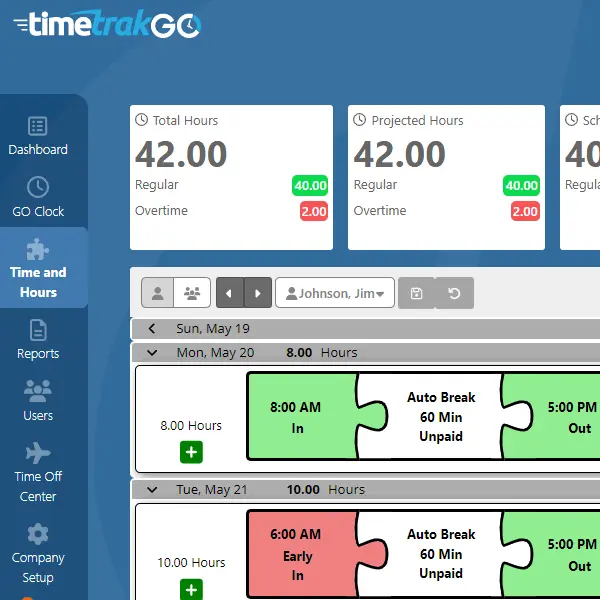Overtime is a costly and common extra expense that businesses often find themselves shelling out every month. With the correct overtime management strategies, employers can reduce expenditures and increase productivity in their workforce. Taking on a few or all of these strategies to manage overtime for your employees will help keep your budget and employee morale in check.
Recognize the Impact of Poorly Managed Overtime
Letting overtime spiral out of control isn’t just a blow to your company’s budget—it can also take a serious toll on your team. When overtime isn’t handled thoughtfully, employees may end up clocking too many hours, leading to exhaustion, plummeting morale, and a general decrease in overall engagement.
This fatigue isn’t just about feeling tired. Overworked staff tend to get less sleep, which can impact both their health and the quality of their work. Mistakes become more likely, and safety can become an issue—nobody wants to run a workplace where errors and accidents are lurking around every corner.
If this pattern continues unchecked, you may also find your workforce growing dependent on overtime pay, making absenteeism more frequent and productivity declines the new normal. In short, failing to rein in overtime can set off a domino effect that affects everything from employee well-being to your bottom line.
Evaluate Workload Assignments
Sometimes, employees find themselves working overtime week after week simply because they have too many tasks or responsibilities on their plates. While having a busy week now and then is acceptable, if employees are consistently working overtime to finish their usual number of functions, it may be time to reevaluate their workloads and implement overtime management.
For example, maybe two coworkers have the same number of tasks within a day, but one always seems to end up falling behind. Look a little deeper, and you may find that that employee has one or two tasks that are more time-consuming than their coworker. In this case, it would be best to reduce this employee’s workload to accommodate for more significant tasks.
Change Staffing and Scheduling
One of the biggest reasons that you may be running into overtime conundrums is understaffing or scheduling. If your business is growing, so should your staff. In a retail store, this might involve putting another employee or two on the schedule on busier days. Or you may need to consider adding another employee to overloaded divisions to even out the workload in an office space.
Adding more employees may not always seem like a way for business owners to save money since it involves paying another employee, but it will pay off. Your current employees will be grateful to reduce their overbearing workloads, and you’ll exchange the costs of overtime wages for a new employee’s standard salary.
Invest Time in Cross-Training
Your business may run into problems when individual employees are the only ones who know how to do specific tasks. These employees may have to work overtime to make up for time out of the office or busy workloads since other employees don’t have the knowledge or skills to pick up the extra workload. Taking the time to cross-train your staff will make a big difference. The top benefits of cross-training employees include:
- Reduced overtime
- Increased productivity during traditional work hours
- Increased flexibility when making work schedules
- Fewer potential bottlenecks in workflow
Use Time Tracking Software
Keeping track of employee hours is time-consuming. If you have a large staff, it can be even more challenging to make sure everyone is staying within their regular hours. One of the best overtime management strategies is web-based employee time tracking software. It requires employees to clock in and clock out on a web-based system that will do the monitoring for you.
With time tracking software, you can see which employees are nearing their allotted hours for the week, who is working overtime hours, and which employees may be abusing the overtime policy.
1. Schedule Analysis: The system analyzes the scheduled working hours of employees for a given period (e.g., a week or pay period).
2. Real-Time Tracking Integration: As employees clock in and out, TimeTrakGO tracks their actual hours worked in real time.
3. Overtime Threshold Calculation: Based on predefined overtime rules (which can be customized according to company policy and labor laws – for instance, some regions mandate overtime after 40 hours in a workweek, while the concept of daily overtime after 8 hours can be a misunderstanding of specific regulations), the system calculates when an employee is approaching or exceeding their regular working hours.
4. Overtime Prediction: The “projected hours” feature then uses the employee’s actual hours worked so far in the period, combined with their remaining scheduled hours, to predict whether they are likely to incur overtime by the end of the period.
5. Visual Alerts and Notifications: TimeTrakGO often provides visual cues, such as color-coded alerts on timesheets or within the scheduling interface, to highlight employees who are on track to work overtime. Supervisors and administrators may also receive notifications when potential overtime situations are detected.
6. Proactive Intervention: This predictive capability allows managers to take proactive steps to manage labor costs.
7. Reporting and Insights: The system typically provides reports that detail projected overtime, allowing businesses to gain insights into their labor costs and make informed decisions about staffing and scheduling in the future.
Allow Flexible Scheduling
More and more businesses today are adopting flexible schedules and work-from-home capabilities. By doing so, employees have the freedom to work around personal commitments. These policies can decrease overtime in two significant ways. First, when an employee can work around other commitments, they don’t have to take time off, which can set them behind on their workload. Instead, employees can pick up where they left off. Additionally, the increase in flexibility can create a happier and more productive workplace, reducing lulls that can lead to unproductive days and the need for overtime hours.
Set a Company-Wide Overtime Cap
One of the most common strategies for managing overtime for your employees is to set a cap. Set an overtime cap that limits how many hours of overtime are available so that no employee abuses overtime pay.
However, make sure you’re fair in your assessment and don’t set the cap too low. In some instances, overtime may be necessary to finish a big project or accommodate a busy season. Setting your overtime cap to a measly extra hour a week might not be enough. Conversely, putting the cap too high will not help reduce overtime spending. Evaluate the average amount of overtime your employees usually require, consider the other changes you plan to make to manage overtime, and develop a transparent and fair policy everyone can work within.
Lead by Example
Company values play a significant role in how your business operates. If employees always see management leaders working overtime, they’re likely to follow in your footsteps. A manager who consistently works overtime may signify to employees that putting in overtime is a sign of dedication and success.
Instead, create a company culture that strives to steer clear of overtime. Show your employees that more time working doesn’t always equate to getting more done. Promote the importance of work-life balance and being open about workloads and capabilities. Your employees will have a happier mindset and more productivity while feeling less pressure to take on overtime work.
Practice Time Management
Excessive overtime may be a result of poor time management skills. Thankfully, this is one of the more straightforward fixes to reduce overtime work. Implement training and seminars as one of your overtime management strategies to improve employees’ time management skills and introduce them to tools and resources that will create better habits.
Use the Right Equipment and Resources
Your employees could be falling behind because they lack the right equipment and resources. Upgrading work processes and tools to more modern options will streamline efficiency, make tasks more comfortable, and reduce the time they take to complete. You may even find your employees have more free time in their days after adopting new tools.
Overtime expenses can kill your monthly budget assets. If overtime wages are hurting your budget and draining your employees of a happy and productive workday, it’s time to implement a few strategies that will reduce employee overtime. From changing the company culture to using employee time tracking systems, your business won’t have to minimize productivity to eliminate costly and time-consuming overtime work.







